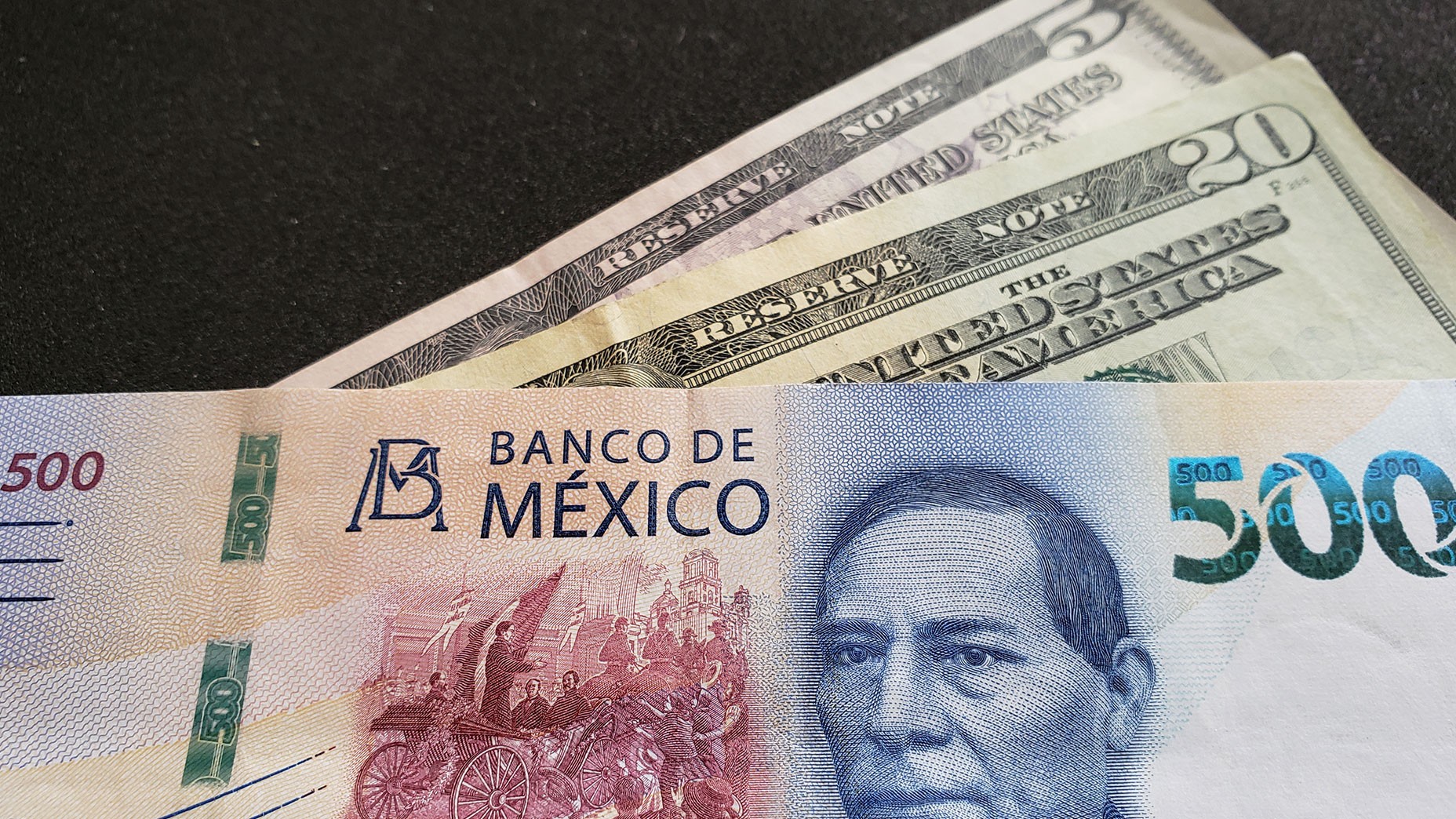USD/MXN Exchange Rate Outlook 2024: Comprehensive Analysis and Future Predictions for Mexican Peso

13 minutes for reading
The USD/MXN pair is one of the most popular currency pairs in Latin American financial markets. This article will examine factors affecting the pair and methods used to analyse and forecast its exchange rate fluctuations. We will study the pair’s performance in 2023 and explore experts’ opinions on its outlook for 2024.
You can visit the RoboForex Market Analysis webpage for the latest forex forecasts.
Overview of the USD/MXN currency pair
The base currency in the USD/MXN pair is the US dollar (USD), the official currency of the US and the global reserve currency in international trade and financial markets. It is considered a benchmark currency and the most widely used asset in transactions worldwide.
The second currency in this pair is the Mexican peso (MXN), the national currency of the United Mexican States. The highest trading volume for this currency in the international foreign exchange market occurs when it is paired with the US dollar.
The USD/MXN exchange rate shows how many pesos the market gives for one US dollar. Fluctuations in the pair’s exchange rate reflect the comparative state of current economic conditions in the US and Mexico. When the USD/MXN exchange rate rises, it indicates a strengthening US dollar against the peso. Conversely, a decline signifies a strengthening Mexican currency against the US dollar.
Mexican Peso: Historical Performance
- 1821: the peso became the official currency of Mexico after the country declared independence from Spain
- 1982: Mexico announced a default on its foreign debt. The country went through an economic crisis, followed by several years of inflation and devaluation
- 1993–1994: the Tequila Crisis occurred, marked by a sharp depreciation of the Mexican peso, leading to an economic crisis. A currency reform followed, with a new Mexican peso replacing the old one at a ratio of 1 to 1,000
- 1994–1995: Mexico entered into an agreement with the International Monetary Fund to stabilise the economy
- 2008: the global financial crisis negatively affected the Mexican peso and currency
- 2013: the government implemented energy and telecommunication reforms, positively impacting the economy and the peso
- 2020: the COVID-19 pandemic harmed the economy and the national currency
Fundamental factors influencing USD/MXN rates
The Bank of Mexico’s monetary policy
The Bank of Mexico (Banco de México, Banxico), the country’s central bank, has been tightening its monetary policy since June 2021 to achieve the inflation target of 3%. Since then, the interest rate was hiked 15 times, rising from 4% to 11.25% at the time of drafting this article on 15 November 2023.
The high interest rate and consistent growth in Mexico’s GDP attract investors. As a result, the peso is showing steady growth against the US dollar and other currencies.
The US Federal Reserve’s monetary policy
The US Federal Reserve also aims to curb mounting inflation by tightening monetary policies. Since 2022, the interest rate has gradually risen from 0.25% to 5.5%, significantly affecting the exchange rate of the US dollar, which had strengthened against several world currencies over this period.
Monetary tightening exerts certain pressure on the US economy. High inflation and slowing economic growth, along with fears over the banking sector’s stability, help create conditions for a potential recession. The USD may decline against the peso and other world currencies in such a scenario.
Oil prices
- Export revenues. Mexico, a prominent oil producer and exporter, sees oil prices significantly affecting the national currency. Rising oil prices increase revenues from Mexican commodity exports, supporting the country’s economy. This rise in revenue may affect the trade balance and contribute to the strengthening of the peso exchange rate
- Trade balance. Increasing oil prices may improve Mexico’s trade balance, as oil export revenues exceed import expenditures. This, in turn, creates favourable conditions for supporting demand for the Mexican peso
- Inflation. With rising oil prices, the country may experience greater inflationary pressure, in turn affecting the Bank of Mexico’s monetary policy and the interest rate. In the case of interest rate hikes, the MXN will strengthen against other currencies
Economic indicators
- Monetary policies of the Bank of Mexico and the US Federal Reserve: changes in interest rates, QE and QT programmes, foreign exchange interventions
- Nonfarm Payrolls
- Unemployment Rate
- GDP Growth Rates (GDP)
- Inflation Indices (CPI, PPI)
- Industrial Production Index
- Retail Sales
- Trade Balance
- Consumer Confidence Index
- The US ISM Manufacturing Purchasing Managers Index
USD/MXN exchange rate dynamics in 2023
In 2023, the USD/MXN pair has demonstrated a consistent downtrend. The Mexican peso is rising against the US dollar, driven by a significant difference in interest rates – 5.5% in the US and 11.25% in Mexico. Thanks to the Latin American country’s elevated interest rate, it is beneficial to buy its national currency against other less income-bearing currencies, including the US dollar.
Mexico's economic indicators show that the economy continues developing, even amid the high rate of the central bank. The country’s GDP is experiencing steady growth, rising by 3.3% in October 2023 compared to the previous year.
The Mexican peso has seen a 12% increase against the US dollar since the beginning of 2023. It is also strengthening its positions against Latin American currencies, rising by nearly 3% against the Brazilian real (BRL) and more than 20% against the Chilean peso (CLP).
Rise of MXN against other currencies in 2023*
Future prospects for USD/MXN
According to the Bank of Mexico’s report for Q2 2023, the regulator raised economic growth forecasts for this year and noted that the pace of expansion in 2024 is expected to be similar to that of 2023. The annual inflation rate is showing signs of a gradual slowdown but remains above the central bank’s target of 3%, standing at 4.26% according to the October data. The Bank of Mexico expects inflation to fall to the target level approximately by Q4 2024.
It is reasonable to presume that the high interest rate of 11.25% and a steady economic growth pace are likely to support the Mexican peso exchange rate at the beginning of 2024. It is worth noting that there have been no signals from the central bank so far about the plans to reduce the interest rate. In the future, the situation will depend on the inflation rate, the GDP, and oil prices. If the oil quotes continue to rise, this may additionally bolster the peso. Conversely, their decline may help the US dollar strengthen against the peso.
In June 2024, Mexico will hold its presidential election, followed by the US presidential election in November of the same year. These events typically exert significant pressure on the exchange rate of national currencies, leading to heightened volatility in their pairs. Consequently, the USD/MXN pair may experience sharp and unpredictable movements depending on the political environment during the elections.
Technical analysis shows that at the time of writing, the USD/MXN pair is trading within a long-term descending price channel, and downward momentum may persist in the near term (Q4 2023-Q2 2024).
In October 2023, following an upward correction, the pair quotes reversed downwards from the upper boundary of a long-term trend. The Alligator indicator and the 200-day SMA show a downtrend on the daily chart, with the potential for the quotes to drop to the lower boundary of the price channel at 16.00. This scenario can be cancelled if the pair surpasses the upper boundary of the price channel and the resistance level at 18.48.
Analysis of the USD/MXN currency pair chart*
Sentiment analysis: Mexican Peso forecasts for 2024
- BBVA bank’s analysts expect the USD/MXN pair to hover at 18.00 by the end of 2023 and 18.80 by the end of 2024
- Economy Forecast Agency (EFA) specialists forecast the USD/MXN pair to be at 16.16 by the end of 2023 and 14.73 by the end of 2024
- According to the Wallet Investor portal, the USD/MXN pair will reach 17.57 in December 2023 and 16.42 in December 2024
Trading characteristics of the USD/MXN currency pair
- The currency pair is traded round the clock every day except for weekends, with the highest trading volumes and maximum volatility observed during the American trading session. It is during this time that both Mexico and the US release significant economic statistics, which strongly influence the pair’s exchange rate
- The USD/MXN pair is highly volatile, characterised by average daily movements ranging between 1,500 and 2.500 pips. During periods of robust activity in global markets, its volatility has the potential to surge to 4,000-5,000 pips per day for a short period
- The pair’s spread is moderate, thanks to high demand and liquidity. In popular ECN accounts, the spread typically ranges from approximately 20 to 30 pips under normal market conditions
How to trade USD/MXN
Trading fundamental factors
Fundamental factor analysis can be employed for both short-term USD/MXN trading during impactful news and long-term trading, primarily based on changes in regulators’ monetary policies.
For example, in 2020, during the stock market declines caused by the COVID-19 pandemic, global oil prices experienced a sharp drop. At that moment, the Mexican peso faced a dual impact from two adverse factors: the strengthening of the US dollar due to investors’ risk aversion and a significant decline in oil prices. Consequently, the peso depreciated significantly. The fundamental idea at that time involved buying the USD/MXN pair in anticipation of further growth before the end of the acute crisis phase and the subsequent recovery of oil prices. Once the crisis was over and oil prices started to rise, it became evident that the pair was sold, expecting quotes to return to pre-crisis levels.
Trading using fundamental analysis*
Trading by tech analysis
This trading method is based on the analysis of a currency pair chart. This involves using classical technical analysis tools, various proprietary techniques, candlestick combinations, Price Action patterns, etc.
For example, following an acute phase of the crisis, in 2020 the daily chart of the USD/MXN pair formed a Triangle pattern. The price movement below the lower pattern boundary signalled a downward correction.
Trading using technical analysis*
Indicator strategies
Signals of a variety of technical indicators can be used. These signals can help automate trading in special programmes – trading advisors.
Let us look at a simple indicator strategy Golden Cross as an example.
- A buy signal forms when the fast EMA with a period of 50 (yellow) crosses the slow EMA with a period of 200 (blue) from the bottom up. Stop Loss is set slightly lower than the local low, and the profit is locked in after signs of a price downward reversal emerge
- A sell signal appears when the fast EMA with a period of 50 (yellow) crosses the slow EMA with a period of 200 (blue) downwards. Stop Loss is set slightly above the local high, and the profit is locked in after signs of a price upward reversal emerge
Trading using indicator strategies*
Conclusion
In 2023, The USD/MXN currency pair exhibits a downtrend, reflecting the strengthening of the Mexican peso against the US dollar. Mexican and US regulators are implementing tighter monetary policies to reduce mounting inflationary pressure, with interest rates at 11.25% and 5.5%, respectively. The peso benefits from a higher interest rate, and the interest rate difference is likely to persist over the next six months.
The pivotal factors influencing further movements in the USD/MXN pair could be the economic growth pace in these countries, central banks’ policies, oil price trends, and the upcoming presidential elections. Mexico will hold presidential elections in June 2024, and the resulting political uncertainty could negatively impact the peso. As the elections approach, there might be an upward correction on the pair’s chart or even a reversal of the downtrend. Later, in November, the US will conduct presidential elections, a significant event that will undoubtedly influence the currency pair’s performance.
FAQ
Is MXN a strong currency?
The strength of the Mexican Peso (MXN) can vary and is influenced by economic factors. It is recommended to check current exchange rates and economic indicators for the latest assessment of the currency's strength.
What factors primarily affect the USD/MXN exchange rate?
The USD/MXN exchange rate is primarily influenced by factors such as interest rates, economic indicators, trade balances, political stability, global events, inflation rates, commodity prices, and market sentiment.
How do global events influence the USD/MXN market?
Global events, such as economic data, interest rate decisions, trade relations, geopolitical events, and crises, can significantly impact the USD/MXN exchange rate by creating uncertainty and influencing investor sentiment and market demand for the dollar and peso.
What are the best strategies for trading USD/MXN?
When trading USD/MXN, consider strategies such as trend following, support/resistance analysis, news trading, and carry trades. Use technical and fundamental analysis, implement risk management, and adapt to market conditions. Diversify your approach, and practice with a demo account before real trading.
How does technical analysis apply to USD/MXN trading?
Technical analysis for USD/MXN trading involves studying historical price data, identifying trends, support/resistance levels, and chart patterns, and using indicators like RSI and MACD. Traders analyse charts, apply tools like Fibonacci retracements, and consider volume to make informed decisions about potential future price movements.
What role do central banks play in the USD/MXN market?
Central banks, such as the US Federal Reserve and the Bank of Mexico, influence the USD/MXN market through decisions on interest rates, monetary policy, currency interventions, and economic data releases. Their actions and statements play a significant role in shaping market sentiment and impacting the exchange rate.
How can traders forecast USD/MXN movements?
Traders forecast USD/MXN movements using technical analysis, fundamental analysis, indicators analysis, monitoring news and events, assessing market sentiment, and considering seasonal patterns and correlations with other markets. It is essential to use a combination of approaches and practice risk management due to the inherent uncertainty in forecasting.
* – The TradingView platform supplies the charts in this article, offering a versatile set of tools for analyzing financial markets. Serving as a cutting-edge online market data charting service, TradingView allows users to engage in technical analysis, explore financial data, and connect with other traders and investors. Additionally, it provides valuable guidance on how to read forex economic calendar effectively and offers insights into other financial assets.













